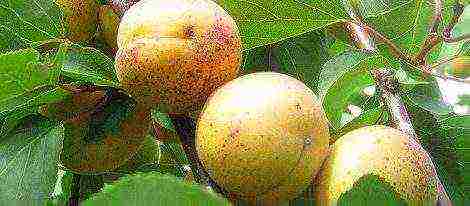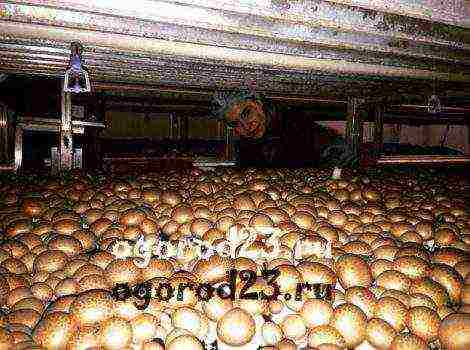Content
- 1 What should you consider before growing grapes?
- 2 Step-by-step technology for growing grapes
- 3 How to properly grow and care for grapes?
- 4 How to grow grapes at home
- 5 Growing features
- 6 Step-by-step technology for growing grape bushes from cuttings
- 7 Why are grapes grown at home?
- 8 What kind of harvest should you expect?
- 9 Seed preparation
- 10 Planting technology
- 11 Growing features
- 12 Tips & Tricks
- 13 Output

Growing grapes is not as difficult as it is commonly believed. Large clusters with juicy fruits will brighten up your vineyard if you follow the basic rules carefully, taking into account the advice of experienced growers.
What should you consider before growing grapes?

Vineyard photo
Why does not every gardener manage to grow good grapes on their plot so that they do not freeze over the winter, do not rot in the summer and bring a bountiful harvest of decent quality? The fact is that the cultivation of this culture must be taken seriously.
First of all, you should choose a suitable grape variety that will feel comfortable in your area. For example, growing grapes in the middle lane gives good results only when using winter-hardy varieties with early ripening. Among the new varieties, you will find many excellent options that are resistant to fungal diseases, pests and severe frosts, with high yields and the ability to ripen even in a cloudy short summer.
Video about growing grapes
Black varieties tend to require more sunlight and warmth than light grapes, although there are some hardy black varieties.
Pay special attention to the appearance of the seedling when buying. Look for any mechanical damage, signs of drying or strange stains on the plant? Healthy grape seedlings should have at least three well-developed roots and a shoot about half a meter high. In order not to doubt the quality of planting material, buy seedlings in the nursery, and preferably in a container - this way the plant will take root better.
It will be easier for a novice gardener to plant a ready-made grape seedling, especially if you want to create a vineyard from scratch. Experienced growers can easily cope with cuttings, but those who are not afraid to experiment can try growing grapes from seed.
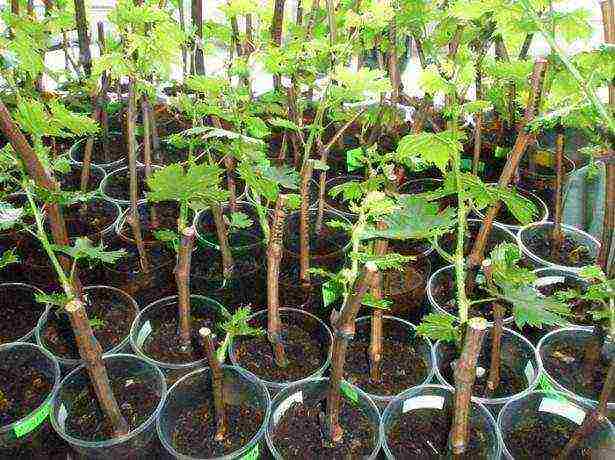
In the photo grape seedlings
Step-by-step technology for growing grapes
When starting to create a vineyard, it is important to take into account the climatic features: if the region is characterized by little snowy winters and severe frosts, it would be preferable to plant grapes in trenches or holes, but if there is enough snow in winter, but the summer is too short and cold, it is better to plant seedlings in bulk ridges. In the pits, the root system will be reliably protected from freezing, and in the ridges, the roots will receive more heat during the summer months.
You can plant grapes both in spring and autumn, depending on which planting material you have chosen. Consider the most common and simplest option - the autumn planting of grapes with seedlings in planting holes.
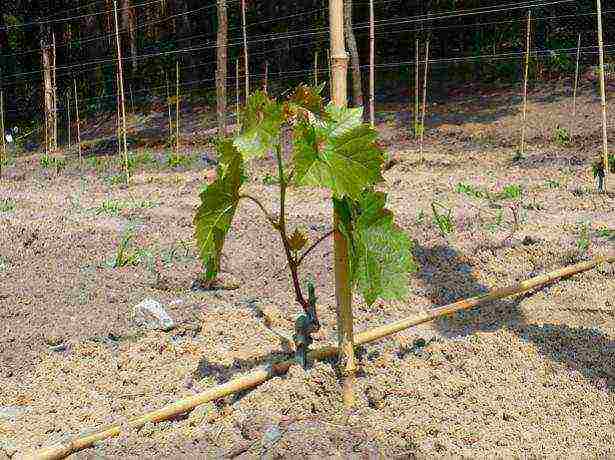
In the photo, planting grapes
Stages of planting a grape seedling:
- choose for planting well-lit by the sun, a flat place where there are no drafts and excess moisture;
- dig a planting hole according to the size of the root system, with a depth of 0.2 to 0.5 m (less for clay soil, deeper for sandy soil);
- mix the soil from the pit with organic and complex mineral fertilizers;
- put a layer of gravel on the bottom of the hole, and put branches or planks on top;
- install a pipe with a diameter of 10 cm or more in order to water the grapes and fertilize the soil through it;
- form a small mound of the prepared earth on top of the layer of gravel and branches;
- before planting, dip the roots of a grape seedling in a solution of clay and rotted mullein (clay is twice as much as a mullein);
- cut the shoots into a couple of buds and dip them in melted paraffin;
- place the seedling in the hole, spreading its roots;
- fill the hole with the remaining soil and tamp it carefully;
- pour warm water over the grapes;
- cover the hole with compost or rotted manure.
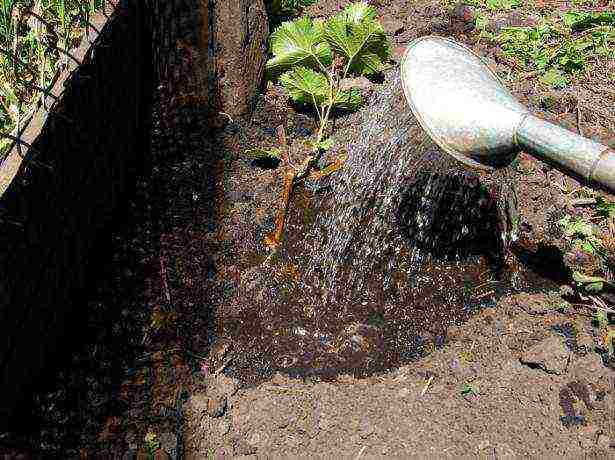
Photo of watering grapes
If you are going to plant several bushes of grapes, leave at least one and a half meters between them. At the same time, it is recommended to arrange plants from the south to the north.
How to properly grow and care for grapes?
For the correct formation of the vines, it is necessary to install a strong trellis. The simplest construction consists of two metal or wooden posts with several rows of wire between them. As the vines grow, they are neatly tied to a wire, giving them the desired direction.
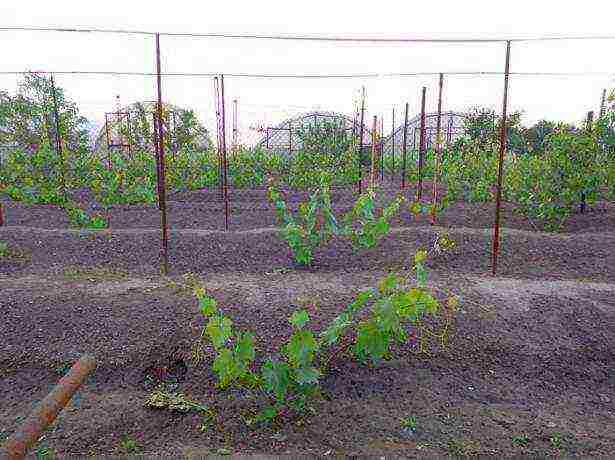
In the photo grapes
In the first three years, pay particular attention to planting: carefully loosen the ground two days after rain or watering, do not allow leaves to wither and dry out the soil from lack of moisture, destroy weeds. From the fourth year on, it is sufficient to water the vineyard three to four times per season during the most important phases of development.
Periodically, the vines should be fed through drainage pipes and along the leaves, and treated with suitable fungicides against pests and diseases. Inspect the plants more often in order to start the fight against dangerous enemies of grapes in time and prevent the death of the entire vineyard!
Video about the technology of growing grapes
Prune the grapes every fall after the fall. With the onset of the first night frosts, remove the vines from the supports, pin them with brackets to the ground, treat with a solution of copper sulfate and cover with plastic wrap. In spring, do not rush to open the grapes until frosts and sudden changes in temperature stop.
By following the grape growing technology outlined in this article, you can create your own vineyard and enjoy delicious, juicy fruits every year.
Rate the article:
(8 votes, average: 4 out of 5)
.
Beginners in the cultivation of grapes can delight themselves with the harvest of delicious berries, growing it on the estate. Few people know that a healthy fruit can be grown independently at home on the balcony and even on the windowsill. It remains to choose a growing method, using cuttings or seeds.

Growing grapes attracts both experienced farmers and amateur gardeners.
In the form of a houseplant, grapes, sprouting on the balcony, purify the air. The leaves of bushes of different varieties, beautiful and varied in shape. In addition to the decorative function, the plant can bear fruit by three or four years of life at home.
Let's consider two main ways of breeding grapes at home. These include - reproduction using seeds, the second - the vegetative method (cuttings).
Breeding grapes from seeds for beginners
Growing grape seedlings from seed is a very painstaking and lengthy process. The plant will begin to bear fruit in the fourth, fifth year.There is little desire for a novice winegrower; for this method, you will have to look for seeds for growing. You can pick up suitable varieties, there are enough of them, but it is important to take seeds from a strong vine. The advantage of the plant is its resistance to diseases, facilitating the process of soil preparation, cultivation.
Different grape varieties grow in specific climatic conditions. Seeds are sown in the spring, if they are sown freshly harvested in the fall. Novice gardeners should choose self-pollinated varieties. The disadvantage of growing grapes from seeds is that the parental properties are not repeated and the berries change the taste. Beginners in this business should think, they need grapes grown in a similar way.
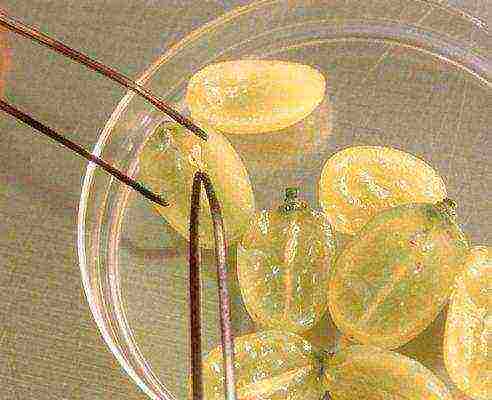
Seeds collected from fresh grapes are planted immediately, in the fall.
Selection and preparation of seeds for planting
First you need to choose a ripe bunch. At home, a seed can germinate, which has a dark shell with a light core, is solid and sinks in water. It is taken out of the berry, washed well, soaked in water for a day, then stored in the refrigerator for two to three months (to improve germination). The process of high-quality germination of seeds should take place in cold, damp conditions (in nature - in winter in the ground). The storage temperature for seeds is from 0 to +3 degrees.
To prevent mold from curling, they are taken out every 10 days, examined and washed with water. The result of stratification appears after 2-3 months, when the grape seed begins to crack, this is a signal that it is ready to plant it in the soil. The germinated seed is moved for two days in a warm place (battery) on a moistened cotton napkin.
Soil preparation and planting seeds
As soon as the white roots begin to emerge near the bone, it is planted in the previously prepared mixture. Fertile soil for planting has a composition in a ratio of one to two sand and humus. For good strengthening of the seed and turning it into a vine, each seed must grow in a separate pot, at a depth of no more than 1.5 cm.
It is allowed to plant seeds in one, volumetric container, at a distance between the shoots 5 centimeters from each other.
Planting pots with seeds are placed in a warm, well-lit place. Ideal - on a windowsill in the southern part of the house. To prevent drying out, soil moisture is controlled by covering the pots from above. After 8-12 days, the seeds give small sprouts.
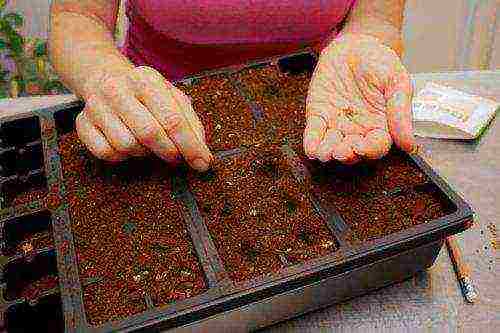
Grape seeds are planted at a distance of 5 cm from each other
The crucial stage of good care of grape sprouts begins. It is necessary to carry out mineral and organic feeding, regulate humidity, light fluxes - at least 8 hours a day. Gardeners recommend feeding the sprout once every 10 days, alternating nitrogen fertilization with phosphorus. The systematic loosening of the soil has a positive effect on the growth of seedlings.
At the beginning of summer, seedlings grow by 8-10 centimeters, then I decide on a transplant. If the owner plans to continue growing them in the room, you need to transfer the seedling into a container with a volume of 3-4 liters and put it on the balcony. The second option is to transplant sprouts directly into the ground.
Chubuki, sprouting on the balcony, are transplanted into open ground in late autumn. In the first year, the vine is not pruned until after the plant has faded for the first time. The vine grown on the balcony reaches 2-3 meters in length. Further, standard preparation for the winter is carried out. They cover the seedlings, for this they remove the vine from the support, fold it into a ring and bend it down to sprinkle it with earth. The raised top of the seedlings is wrapped with prepared material (black film, agricultural cloth). For 3-4 years of careful cultivation of grapes, the fruiting period begins.
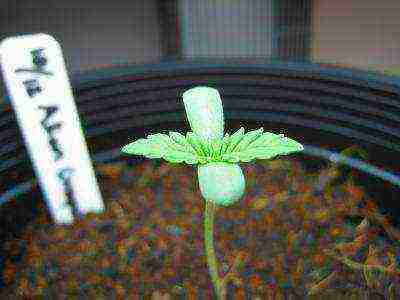
Until the sprout has reached a length of 10 cm, it cannot be transplanted.
Growing seedlings at home
The vegetative method provides for the cultivation of grapes in spring, summer, winter cuttings. For high-quality cultivation of grapes, it is necessary to correctly prepare the cuttings (shanks). Chubuki are ready-made cuttings that have one or five buds. Growing grape seedlings using the vegetative method does not violate the palatability of the fruit. This method of growing vines is reliable for the formation of good quality seedlings. From the step-by-step execution of the instructions, the result of the venture depends on getting delicious grapes.
The preparatory phase of the breeding of shanks includes:
- Cutting the shanks.
- Storage of workpieces.
- Preparation for growing vines.
For grape cuttings, a favorable autumn period. With the onset of cold weather, when the leaves of the plant fall off, gardeners start cutting the vines. For high-quality reproduction of shanks, take medium shoots from the upper part of straight vines from fruit branches of grapes. After grafting is completed, they are soaked in a bucket for a day and sent for storage.
Then each stalk is taken out of the water, marked, sorted into a bunch and wrapped with a damp cloth, sent to storage in a refrigerator or cellar. At 100% humidity, the storage temperature is - + 4 ° C. Periodically, the safety of the shanks is checked so that mold and early discoloration of the kidneys do not appear.
From the second month of spring, the process of cuttings is continued, for this the seedlings are thawed and checked for viability. A transverse cut is made with a pruner, when water drops appear, defrost further. Lack of water indicates dried up seedlings, and digging in indicates that it is rotten. The workpieces are taken from the refrigerator, washed in cool water, disinfected in manganese for 6 hours. Then the sections are updated, and the cuttings are left in clean water for two days.
The color of the slice matters - light green without black dots. For active growth of the root system, a root formation stimulator is added to the water.
The stage of growing cuttings at home continues.
The stems are planted in disposable cups or bottles in order to better observe the development of sprouts. Some gardeners practice planting shanks in boxes, other containers or directly into the ground, so as not to disturb the roots of the plant once again.
Winter cuttings, after treatment with a stimulant, planting in greenhouse conditions, take root up to 90 percent. During the growing season, the shoots reach 1.5 meters, by the end of the first year, the roots germinate up to 30-40 cm long. Only from the fall of the second or spring of the third year, seedlings are planted in open ground in a permanent place.
Cuttings are planted in glasses and placed in boxes
Growing grapes in barrels
Winegrowers have developed a new method of growing vines in barrels. This option is suitable for areas where the summer day is short. It is as follows:
- pick up plastic barrels with a minimum volume of sixty-five liters (that is, for 50 liters of soil). Before planting grapes in barrels, drilled at the bottom up to 40 technical holes, 10 millimeters wide;
- for drainage, expanded clay is settled into the lower part of the barrels, you can use slag, as well as broken brick. The space is filled with soil mixture, the composition of which is close to the components of the garden soil: sand, add humus, peat;
- when the middle of autumn comes, the sprouts in barrels are settled on the soil of the estate so that a small angle is obtained with a distance of 1 meter between them. During cold weather, to prevent shoots from freezing in barrels, they are sprinkled with soil and covered with slate;
- starting in April, the barrels are removed from the ground and placed in the greenhouse. Thus, the vine, planted in the soil of the container, undergoes heating and blooms by the month of May;
- grapes are brought out to the street in early summer, placed on the south side, with the provision of shade for the plant.A year of laborious efforts and in July the plant will give a long-awaited harvest.
Varieties of small stature are planted in barrels - "White Delight", experts suggest "Dimon", "Madeleine Selenium", others are known. Planting grapes in this way is aged from eight to ten years, then the containers are cut, the bushes are taken out for transplanting into open ground.
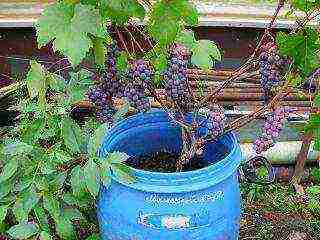
For planting grapes, barrels with a size of at least 65 liters are selected
Features of growing grapes on the balcony
Breeding and growing grapes on the balcony is best done on the south side of the house. With good watering, the plant gives a fairly good harvest of fruits. Also, the vine shades the window and is a decorative element of the balcony. Not all grape varieties are suitable for living on a windowsill or balcony. Popular varieties include Delight, Timur, medium-sized varieties such as Prim, Russian early will still take root. In order for the plant to develop, the following conditions must be met:
- the main condition for growing a vine is sufficient lighting, only under direct rays the plant will bear fruit;
- the use of growth stimulants during the cultivation of grapes on the balcony improves the ovaries and accelerates the ripening of berries;
- pay special attention to the composition of the soil, since the plant is not in its natural environment. The soil consists, on average, of five parts of useful substrates;
- grape varieties growing in a room or balcony must be bisexual;
- as they grow, the grapes will need to be transplanted into larger forms. In the first year of breeding, the plant will live in a 4-5 liter pot, after 2-3 years it will need to be transplanted into a conical container of 8-10 liters;
- in winter, grapes can spend on the balcony in a pot if they are wrapped in blankets and covered with foil. If there is a basement, the plant, after pruning the vine, can be lowered into it until February.
With proper care of the vine bush on the balcony, you can expect a healthy looking green vine and many years of fruiting.
Growing grapes from seeds on your balcony or windowsill is a rather difficult path and does not always justify itself. The plant can bear fruit only by three, four years of life.
For novice gardeners, growing grapes from cuttings is suitable. This method is much easier and with proper care of the plant, from year to year, it will delight you with a tasty and healthy harvest.
Subscribe Be aware of new products on our site
Grapes are a very thermophilic plant and we are used to growing them on huge plantations, mainly in southern countries. But over the past few decades, through the efforts of breeders, many hybrid varieties have been bred that can bear fruit in central Russia, and even closer to the north in closed greenhouses. At an average ripening temperature of + 18 ° C, you can get a harvest of juicy, fragrant berries in just 100-110 days. We will talk about the cultivation and cultivation of such grapes further.
How to grow grapes at home
Grapes are exactly the kind of culture that does not propagate by seeds, since in this case it does not retain its original genetic characteristics. It is not always possible to buy a ready-made seedling of a favorite variety. That is why the most accessible and widespread method of propagation of vines - cuttings.
Its availability lies in the fact that at home it is very easy to preserve, plant and root grape cuttings, prepare them for planting in open ground or a greenhouse. It is best to do this at home, since the rooting process should begin no later than late February - early March.
The most important thing is to choose a grape variety that is good at rooting.
Now, very many hybrid varieties have this ability, since cuttings are one of the main areas of work for breeders.Most often, gardeners like to plant table varieties on a garden plot with excellent taste, sugar content, large berries (preferably seedless), with early or mid-ripening periods. The varieties meet almost all these requirements: Delight, Kesha, Pleven, various varieties of Kishmish, Laura, Kodryanka, Anyuta, Aleshenkin, Veles and many others.
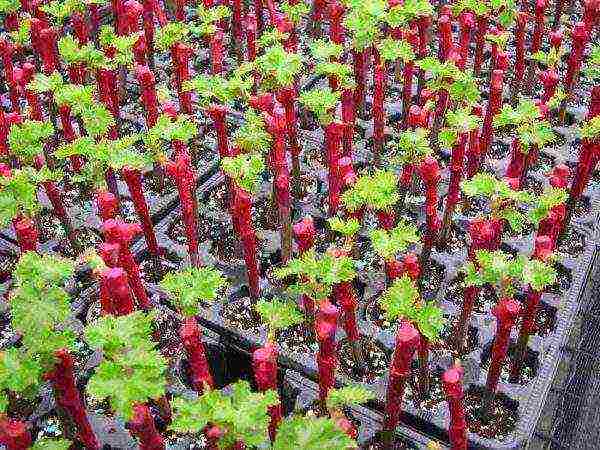 Before planting grapes in the ground, it is necessary to germinate the cuttings and wait for the first leaves to appear.
Before planting grapes in the ground, it is necessary to germinate the cuttings and wait for the first leaves to appear.
Growing features
Growing grapes in a greenhouse or in the open field directly depends on the natural climatic conditions of the region. It is clear that in the southern regions in the open field, grapes will have time to ripen not only early varieties, but also later ones. But in the Middle zone, the Moscow region and further to the north in open soils, only the harvest of the earliest varieties will ripen.
In regions where summers are short and winters are cold, it is best to grow vines in greenhouses in order to enjoy the taste of berries with different ripening periods for a longer time. But indoors, you will have to more carefully monitor the health of the bushes., microclimate, soil condition, since cases of fungal and other infections spread much faster. In an enclosed space, it is easier to prevent the occurrence of typical diseases than to eradicate them.
Step-by-step technology for growing grape bushes from cuttings
The whole process of obtaining rooted seedlings takes several months, but it is not very difficult in terms of labor intensity. Even novice gardeners who decide to take up viticulture are able to achieve the best results - this culture is so unpretentious, although it requires some attention. The main thing is to properly care for and carry out certain activities on time.
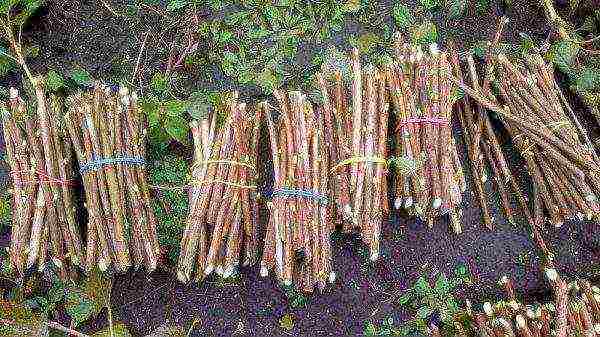 Chopped grape cuttings
Chopped grape cuttings
Cutting and storing shanks
The very first stage is the preparation of planting material. During the pruning of grapes in the fall, when all the branches bearing fruit this year are removed, cuttings are being prepared. It is the fruit branches that serve as the best material for future seedlings. What is necessary take into account:
- pruning is carried out after leaf fall, before the onset of the first frost;
- the vine should be as straight as possible, healthy, light brown or sandy in color;
- the longer the stalk, the better the reproduction will be.
The branch should be without visible damage, with a light bark, on the cut - green, with droplets of liquid (juice) protruding on it, the lower cut is made straight, and the upper cut oblique. Cutting length - at least 40-45 cm, cut diameter - 10-12 mm + 3-4 living buds with an interval of 10 cm between them.Sections should be made with a very sharp secateurs or a knife so that their tissues do not wrinkle, at a distance of at least 2 from the buds -3 cm.
Cut cuttings must be prepared for storage:
- soak in cold water for 1-2 days, changing the water 2 times a day;
- process with a solution of vitriol or potassium permanganate (it is best to soak for half an hour);
- spread out on paper napkins (towels) and dry well from excess moisture;
- collect cuttings in a bunch, wrap tightly in plastic wrap, tie, fix a tag with the name of the variety (if there are grapes of several varieties, you need to store them in different bags, since different varieties have a bad effect on each other during storage); instead of a film, you can use plastic bottles - lower the vine through the neck and close the lid.
Store the cuttings at t 0 + 5оС (a refrigerator, a glazed balcony, a basement will do).
 Cuttings can be stored both in the refrigerator and in the basement
Cuttings can be stored both in the refrigerator and in the basement
Preparation for rooting
In late February - early March, they begin to root the planting material. First you need to check how the material was preserved. To do this, the sections are updated, each at a distance of 0.5-2 cm from the upper and lower buds, respectively, in an oblique and direct way - they should be green and moist.Then the cuttings are immersed in water for 1-2 days (depending on the degree of dryness of the branches), to stimulate growth, it is necessary to add honey, aloe juice or humate (1 tablespoon / 10l of water).
At the lower heel, where the roots will grow, several grooves 2-3 mm deep and 2 cm long should be made with a needle - this will help to get a more developed, lush root system. The upper cut can be treated with paraffin.
 Checking cuttings for safety
Checking cuttings for safety
Germinating the cuttings in water
Put a layer of cotton wool about 2 cm on the bottom in an ordinary glass liter jar, pour the same amount of water (melted water is best), lower the cuttings. The heel - the bottom edge - should be in the water at a depth of 4-5 cm. To avoid decay of the liquid, you can put 2-3 tablets of activated carbon, add water periodically. On top of the jar, you can put on a plastic bag to create a greenhouse effect, put it on the windowsill.
Grapes, like any plant, need an abundance of light and warmth to grow vigorously. Twigs will appear first, and then roots. In order for the root system to develop, the shoots should be broken off; for a bush, one, the very last shoot will be enough.
Planting in pots in a greenhouse or greenhouse
The soil for the seedlings must be prepared in the fall by mixing equal amounts of turf soil, peat, sand, rotted manure or compost; ready-made mixture from the store is also suitable. As a container, you can use plastic bottles, larger disposable cups, etc., make drainage holes. A little drainage is poured at the bottom of the container, then the prepared soil, the cutting is carefully lowered onto it, poured with soil, slightly (!) Moistened.
The heel of the seedling should be at a depth of 1/3 of the container, and young shoots above the ground. Approximately until the end of May - beginning of June, young seedlings will have time to root well, develop full-fledged leaves and branches, and prepare for planting in the ground.
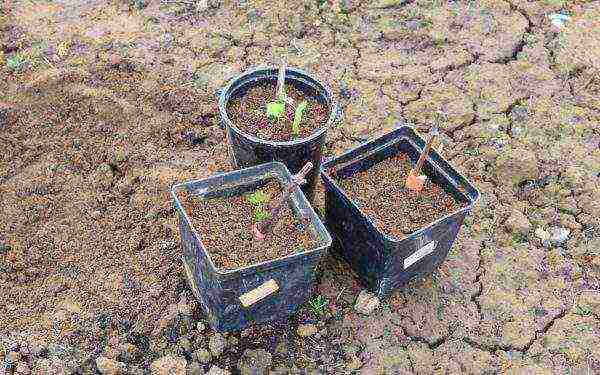 Planted shanks in pots
Planted shanks in pots
Rooting in sawdust or soil
In the southern regions, where in March the soil warms up to a temperature of 10-12 degrees at a depth of 10 cm, cuttings after processing and soaking can be planted directly into the ground - a school. Planting is done in prepared, well-fertilized soil to a depth of 40 cm. The cuttings are laid in pits (or a furrow), covered with earth up to half, tamped well, watered abundantly, pits are filled up to the top. 2 buds should remain on the surface of the earth. Focusing on the climate of the region, you can cover the surface or temporarily cover it with a film.
Another fairly common way to germinate cuttings is in sawdust.
The sawdust should only be of deciduous trees, without any admixture of harmful plywood or chipboard sawdust. They must be steamed before use - pour boiling water, then cool and in a deep dish (bucket) first pour a small layer on the bottom. Then, in an inclined state, lay out the sawdust in layers, placing the cuttings vertically between them. After planting, cover the dishes with foil, put them in a warm place and moisten the environment from time to time until sprouts and roots appear.
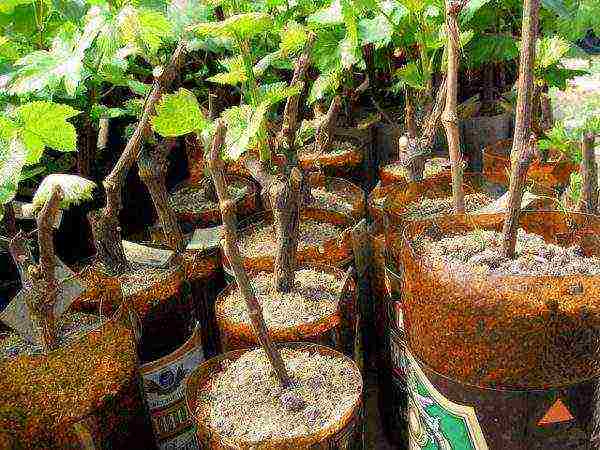 Rooting grapes in sawdust
Rooting grapes in sawdust
Correct planting of seedlings in open ground
The technology for planting in open ground is simple. The finished rooted seedling is first prepared for planting in open ground. To do this, within 5-7 days, seedlings in pots are taken out into the street, avoiding direct sunlight. After hardening, cuttings are lowered into the prepared holes along with an earthen lump, the holes are poured with earth mixed with humus, watered with warm water. The main thing is not to deepen the plant and water it moderately. In order not to damage the roots during planting, it is better to carefully cut plastic cups or other containers, then remove the seedling with an earthen clod.
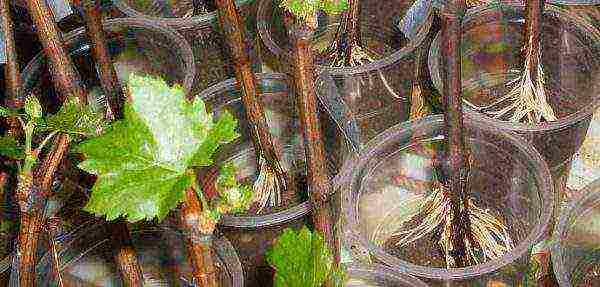 Rooted grapes ready to plant
Rooted grapes ready to plant
Be sure to immediately fix the support next to the grape seedling planted in the ground!
Germinating a grape stalk, rooting it and growing a seedling of your favorite crunchy sweet berry is not a lot of work. This can be done both in a polycarbonate greenhouse or greenhouse, and in the open field. Proper care for your pet - and he will thank you with active growth and a rich harvest, literally, in two or three years.
Everyone knows such a plant as grapes, the cultivation of seeds of which at home is of interest to many gardeners. To get a fruiting bush, you need to know the correct technology for this method and tune in to the fact that it will last for quite a long time. Not many growers and gardeners use this method, since it is quite complicated and not everyone is able to cope with it.
Why are grapes grown at home?
Ways to grow grapes at home:
- using cuttings;
- using seeds.
The last method is the most time consuming and painstaking, so not many people take it. Let's consider just such a growing method in more detail.
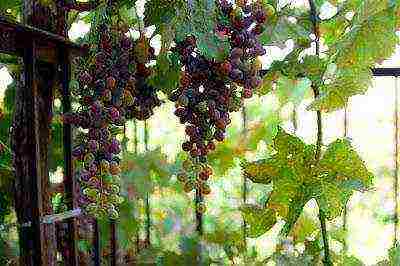
When asked whether it is possible to grow grapes from seed at home, experienced breeders and winegrowers answer positively. But the harvest is quite modest, so gardeners are doing this for the sake of:
- Excitement. Growing such a plant is long and difficult, and this process requires a lot of effort, constant attention and care. Not every gardener will be able to grow a garden crop in a pot from a small seed.
- Experiment. For those who develop new varieties, grapes from the seed can become a kind of "guinea pig" on which you can try out various feedings, as well as track how the plant reacts to pests, diseases and other negative factors.
- Rootstock. Grapes, grown from seeds of which takes place in an apartment, are used as a support for an ordinary garden vine. This will also save on seedlings.
- Decorating. Grown "home" grapes are no different in appearance from garden grapes. And since the plant itself is very beautiful, you can decorate your balcony with it.
What kind of harvest should you expect?

Berries obtained from the "home" vine, their taste is significantly different from the garden. Grapes begin to bear fruit after planting in 4-5 years. For the first time, the yield is expected to be rather low, and the taste of the berries is sour or have a weak taste.
Seed preparation
Due attention should be paid to the preparation of seeds for planting. It is best to choose new varieties, as this ensures that the grapes grown from the seeds at home will be resistant to various diseases and adverse conditions. The seeds must be extracted from the most ripe berries, differing in varietal qualities, without deformation and without signs of rot.

Grape seeds that will be used for home cultivation must be very large and preferably beige-brown in color. They are carefully and very thoroughly washed under water, and then not dried, but immediately laid out in moistened nylon bags and wrapped in ordinary plastic wrap. It is recommended to place prepared grape seeds on the lowest shelf in the refrigerator. They should be inspected regularly and flushed periodically. As soon as cracks appear on them after a few months, this indicates their readiness for planting in the ground.
Planting technology
Is it possible to grow grapes from seed at home? If done correctly, then it is quite feasible. Sprouted grape seeds are planted in individual containers, which are filled with fertile soil.The optimum soil consists of a mixture of humus and sifted sand. Before sowing seeds, the soil should be disinfected; for this, the soil is calcined in an oven at a high temperature or spilled with boiling water with the addition of potassium permanganate.
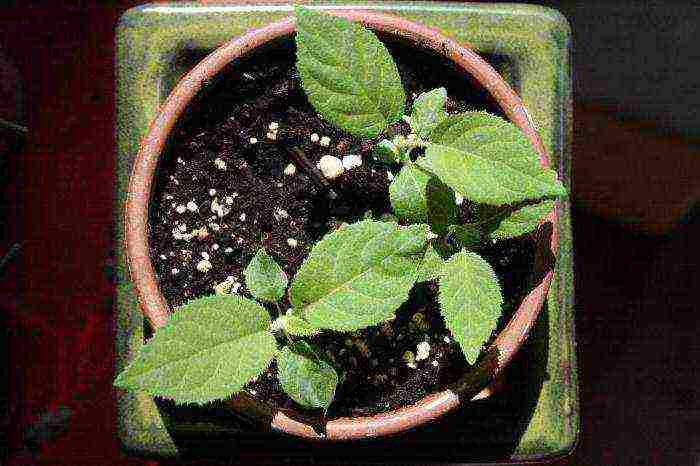
After the containers are filled with soil, it is moistened and the prepared grape seeds are planted to a depth of 1-1.5 cm. In order for the sprouts to appear as early as possible, it is better to place the seed pots on the windowsill, where there is good illumination and a lot of heat.
Growing features
If, when growing grapes from seeds at home, an optimal temperature regime is created, and the crops are provided with the necessary amount of light, then sprouts can be expected to appear in 10 days.
The conditions for growing grapes are as follows:
- plants must be regularly watered with water at room temperature, but waterlogging or severe drying of the soil must not be allowed;
- the soil must be loosened, and this must be done very carefully so as not to harm the sprouts;
- if such a need arises, then irrigation is supplemented with fertilizing with mineral and organic fertilizers;
- the plant should be protected from drafts, and if the weather is very sunny, then the grapes should be shaded.
It is necessary to regularly inspect seedlings, as young plants are often affected by diseases or spider mites. In the spring they are transplanted into larger containers.
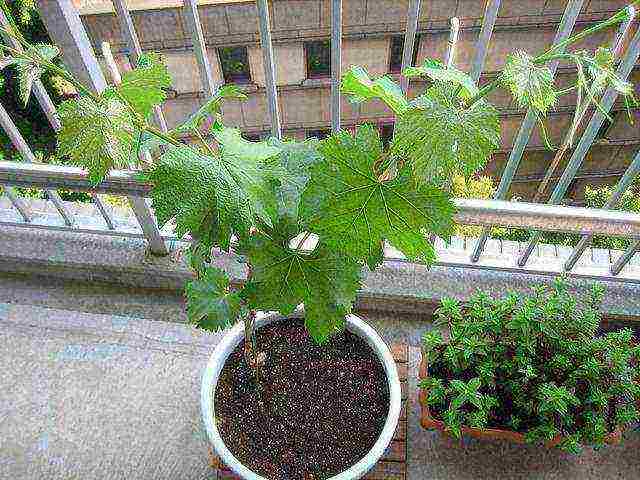
If grape seedlings are grown, then next year they are recommended to be transplanted into open ground. It is also very important to harden the plants before they are planted in a permanent place. Thanks to this procedure, they quickly adapt to new growing conditions and take root faster.
Tips & Tricks

Growing grapes at home lasts until it reaches a height of 1.5-2 meters. After that, seedlings can only develop in the open field. In this case, the conditions for growing the plant are as follows:
- The landing site should be well lit and not in a draft. It is best if there is protection from the north side.
- It is advisable to choose a site with light, breathable and moderately moist soil.
- Usually, grapes are grown on trellises, which are very strong supports of two meters in height with a stretched wire. There should be a distance of 1.5 or 2 meters between the planted plants.
- Grapes need to provide good drainage in the form of medium-sized stones or broken bricks. It is recommended to fill it up with high-quality and fertile soil.
In the future, caring for the planted grapes provides for regular watering, loosening the soil, and fertilizing. If you properly care for the plant, then it will begin to bear fruit in three or four years after planting the grape seed.
Output
Thus, we have sorted out what constitutes grapes, the cultivation of seeds of which takes place in an apartment or a private house. This process is very complicated and only experienced gardeners can do it. You can not only decorate your own balcony with a grown vine, but also enjoy berries.

